From the Trenches
The Pink Standard
By DANIEL WEISS
Monday, December 11, 2017
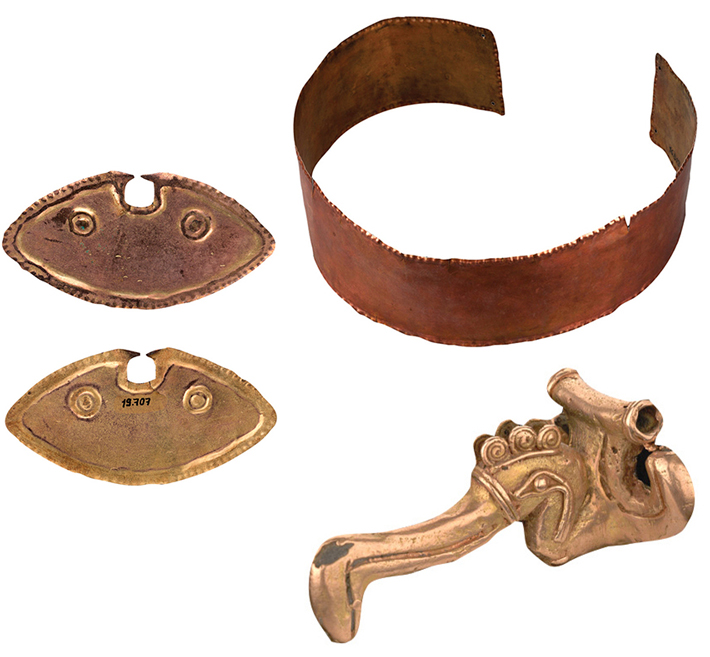
Gold is generally thought to have been prized by people throughout human history, and researchers have discovered that the Nahuange, who lived in northern Colombia during the first millennium A.D., intentionally treated gold jewelry to turn it a pinkish orange. Marcos Martinón-Torres of University College London and Juanita Sáenz-Samper of the Museum of Gold in Colombia analyzed 44 Nahuange artifacts in the museum’s collection that were made from tumbaga, a gold alloy containing a substantial amount of copper.
All the objects were initially subjected to “depletion gilding,” in which copper is removed from the surface through hammering, annealing, or both, producing a golden surface that belies the metal’s true contents. This gilding was later deliberately removed, bringing out the copper’s pinkish tones. “We suggest that at a particular moment, it was desirable for an object to be golden, and at a later point, it was desirable to have the gilding removed,” says Martinón-Torres. He adds that red has been associated with the feminine in the region, so objects may have been turned pink when a woman took ownership of them or when a female owner entered puberty.
A Monumental Find
By JARRETT A. LOBELL
Monday, December 11, 2017
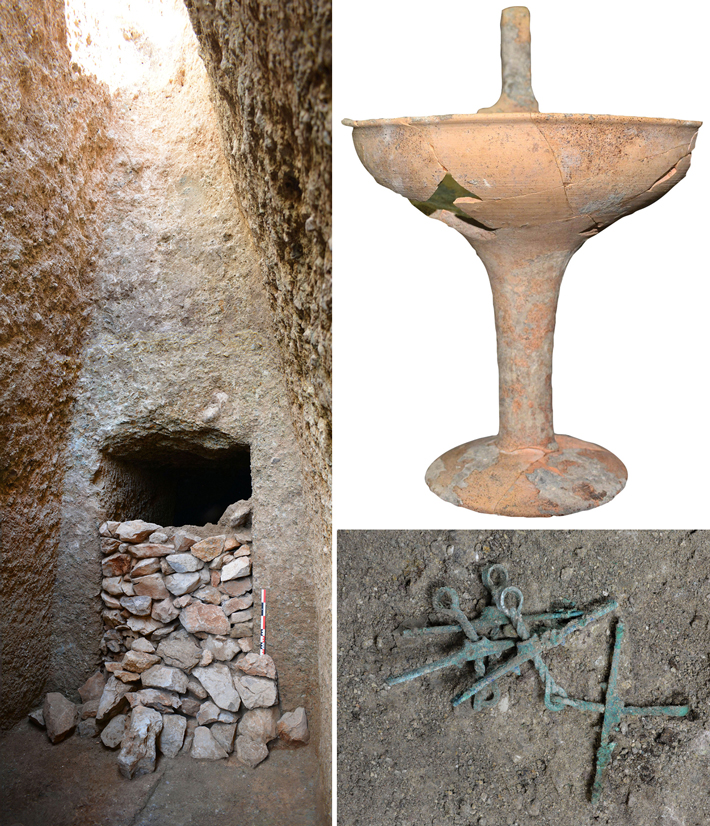 A monumental rock-cut chamber tomb has been excavated in central Greece near the ancient city of Orchomenos, the most important regional center during the Mycenaean period. In a cemetery of similar structures, this tomb is distinguished by its size—at 452 square feet, it is the ninth largest of the more than 4,000 Mycenaean chamber tombs excavated over the last 150 years, says University of Cambridge archaeologist Yannis Galanakis. It is even more notable for its contents, which include the remains of one man and a substantial amount of jewelry. “Mycenaean rock-cut chamber tombs were used for multiple burials, so to find only one burial is extraordinary,” says Galanakis. The artifacts have also surprised scholars. “There is very little painted pottery, which is always found in contemporary tombs,” explains Galanakis. “But there is a lot of jewelry, which previously has been ascribed to female burials. Now we can ask why certain objects were selected while others weren’t.”
A monumental rock-cut chamber tomb has been excavated in central Greece near the ancient city of Orchomenos, the most important regional center during the Mycenaean period. In a cemetery of similar structures, this tomb is distinguished by its size—at 452 square feet, it is the ninth largest of the more than 4,000 Mycenaean chamber tombs excavated over the last 150 years, says University of Cambridge archaeologist Yannis Galanakis. It is even more notable for its contents, which include the remains of one man and a substantial amount of jewelry. “Mycenaean rock-cut chamber tombs were used for multiple burials, so to find only one burial is extraordinary,” says Galanakis. The artifacts have also surprised scholars. “There is very little painted pottery, which is always found in contemporary tombs,” explains Galanakis. “But there is a lot of jewelry, which previously has been ascribed to female burials. Now we can ask why certain objects were selected while others weren’t.”
The Secrets of Sabotage
By JARRETT A. LOBELL
Monday, December 11, 2017
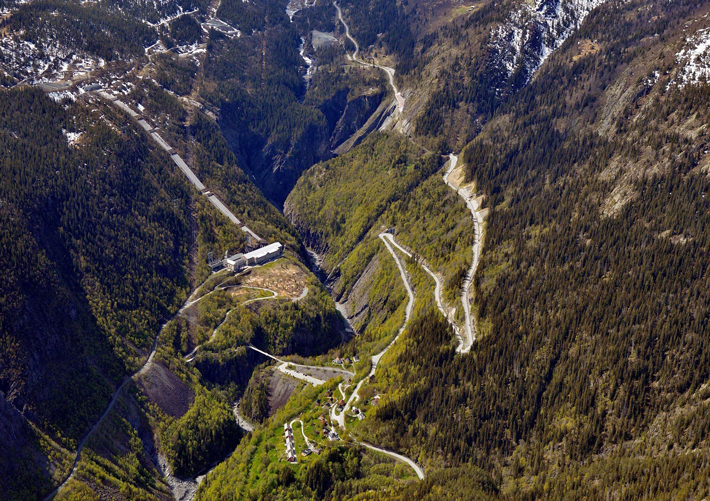
One of history’s greatest “what ifs” is the question of what would have happened had the Germans been able to develop nuclear weapons during the Second World War. The Wehrmacht’s effort to do just that, called the Uranverein, or “Uranium Club,” began in 1939 when German Army physicist Kurt Diebner began to research the potential military applications of nuclear fission. By year’s end, the renowned German physicist Werner Heisenberg had expressed his belief that nuclear fission chain reactions, and thus, eventually, nuclear bombs, might be possible, but only if he had access to enough of a singular substance known as heavy water.
No facilities for manufacturing heavy water existed in Germany. But on April 9, 1940, the Germans invaded Norway, and in so doing acquired the Vemork Norsk Hydro Plant outside Rjukan, which, in 1934, had become the world’s first commercial heavy water plant. Heavy water, or deuterium oxide, exists when the normal hydrogen atoms are replaced with the hydrogen isotope deuterium, which has both a neutron and proton in its nucleus, thus making it “heavier” than proton-only hydrogen. In nuclear fission reactions, whether in an atomic bomb or a nuclear power plant, heavy water is used to slow down and regulate the reaction. Once Germany controlled Norway, it controlled not only most of the world’s existing supply of heavy water, but also Europe’s only means of producing it. Soon, the Allies believed, Heisenberg would have all he needed to fuel his “uranium machine,” and the Uranverein would be well on the way to developing a nuclear bomb.
Fear of an atomic Germany was the driving force behind not only the race for the Allies to develop their own nuclear bomb capability—and thus the Manhattan Project—but also for their determination to destroy Vemork. Hence, the British Special Operations Executive (SOE), which was responsible for sabotage operations, initiated plans to cripple or obliterate the plant’s heavy water production facility in November 1942.
After that attempt failed, the SOE conceived of Operation Gunnerside. For Gunnerside, Norwegian fighters trained in Scotland joined members of the earlier team who had remained in Norway. The operatives’ approach to Vemork on the night of February 27, 1943, entailed climbing down—and then scaling—an icy 656-foot-ravine. Upon entering the plant, the team went immediately to the heavy water room, placed their explosives, and exited the facility before the explosives detonated, destroying the heavy water production capability, and also more than 100 gallons of the priceless liquid.
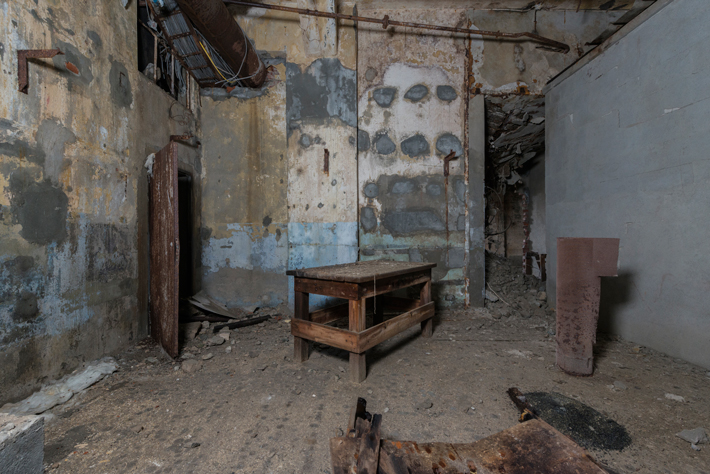 Operation Gunnerside has been called the most successful act of sabotage of World War II. But the actual heavy water room where it took place had not been documented or studied since Gunnerside. Norsk Hydro, which had ultimately resumed operations, ceased producing hydrogen and heavy water at the plant in 1971, and the abandoned factory was demolished six years later.
Operation Gunnerside has been called the most successful act of sabotage of World War II. But the actual heavy water room where it took place had not been documented or studied since Gunnerside. Norsk Hydro, which had ultimately resumed operations, ceased producing hydrogen and heavy water at the plant in 1971, and the abandoned factory was demolished six years later.
In September 2017, in anticipation of the seventy-fifth anniversary of Gunnerside, archaeologists Sindre Arnkværn and Line Grindkåsa of the Telemark County Council began a project to explore what might be left among the rubble. Several weeks after beginning their work, the team reached the basement, where, surprisingly, they found the heavy water room intact and in very good condition.
Joachim Rønneberg, Gunnerside’s leader, is now 98 years old and is the only saboteur still alive. For many years, Arnkværn says, Rønneberg has wished for the plant to be excavated. “If we are fortunate enough to interview Mr. Rønneberg and to learn specifically where the events unfolded, that will be tremendous,” he says. “Nothing can compare to the excitement of excavating something people will actually be able to walk into and of conveying the story of one of the most remarkable events of the Second World War.”
|
Slideshow:
|
3D Walkaround:
|
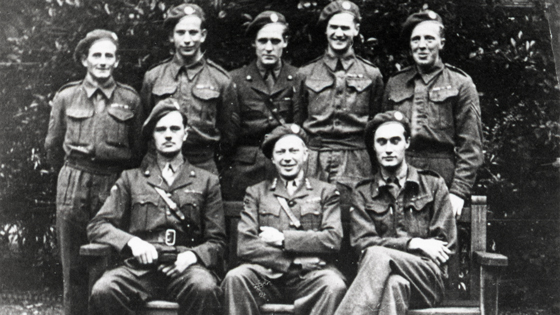
Operation Gunnerside
|
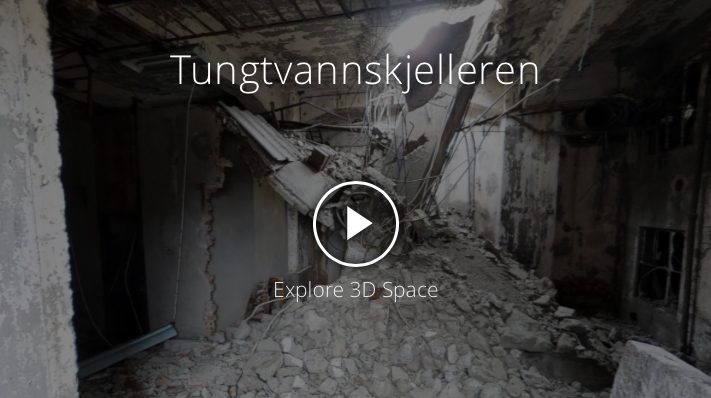
Inside Vemork Plant
|
Off the Grid
By MARLEY BROWN
Monday, December 11, 2017
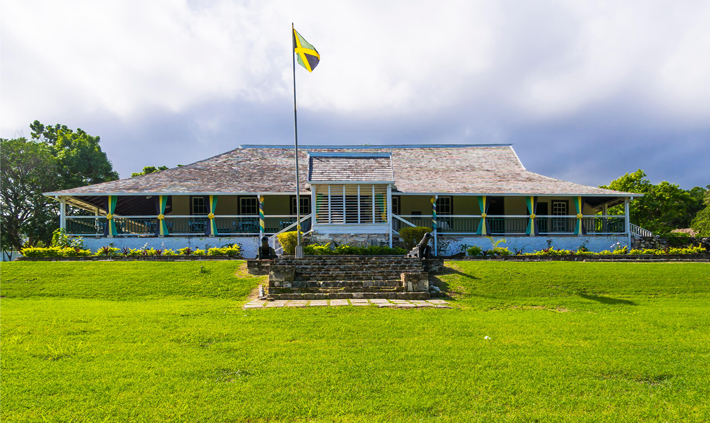
Overlooking the Caribbean Sea, just outside the town of Saint Ann’s Bay on Jamaica’s north shore, Seville Heritage Park encompasses thousands of years of the island’s history. The 300-acre property has been settled during every period of Jamaica’s human occupation. It contains the remains of Maima, an indigenous Taino village that Christopher Columbus encountered upon first landing in Jamaica in 1494. In 1509 the Spanish founded their first colonial capital there, which they called Sevilla la Nueva, before abandoning it in 1534. England invaded Jamaica and wrested control from Spain in 1655. As a reward for service to the army during that campaign, English captain Richard Heming was given the land. In 1670, he established a sugar plantation that, until emancipation in 1838, was home to an average of 275 enslaved African Jamaicans in any given year. The majority of that community lived in a village behind the eighteenth-century “Great House,” the planter’s residence built in 1745 by Heming’s grandson. The house still stands and is now a museum that tells Seville’s story. Claudette Anderson, Jamaica National Heritage Trust operations manager, explains that Seville can be seen as the birthplace of modern Jamaica, a spot where the nation’s identity was forged. “We interpret the lives of people from four cultures,” she says. “The Taino, African people, the British, and the Spanish: They all make up who we are as Jamaicans today.”
THE SITE
The Great House now hosts Seville’s museum, and has an exhibit covering Jamaica’s history from the earliest evidence of human presence in the area, about A.D. 650, to the beginning of the twentieth century. A guided tour includes a visit to reconstructions of both the Taino and the enslaved African villages, and remnants of the plantation, such as a massive water wheel used to pulp sugarcane. Though Seville doesn’t currently offer a tour of the remains of the Spanish capital, which include the ruins of the governor’s mansion and a sixteenth-century church, the staff tries to accommodate groups of interested travelers who call ahead.
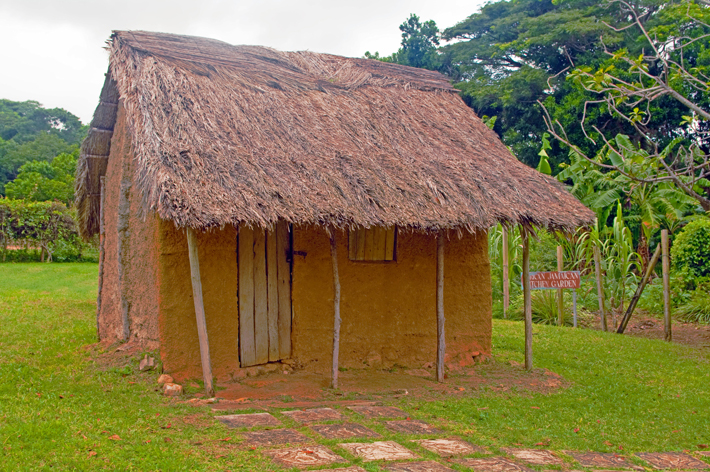 WHILE YOU'RE THERE
WHILE YOU'RE THERE
Begin your visit in Seville’s Great House, which gives you a historical overview of the site and displays artifacts uncovered by archaeologists. From there, take advantage of a guided tour or a tour of the property on horseback. About a 20-minute drive west, travelers can also visit the Green Grotto Caves, a complex thought to have been used for shelter throughout the centuries by native Tainos, escaped slaves, and smugglers.
Advertisement
Advertisement
IN THIS ISSUE
From the Trenches
The Secrets of Sabotage
Off the Grid
A Monumental Find
The Pink Standard
Hot Property
Spotting the Sun
Bronze Beauty
Masked Man
Queen of the Old Kingdom
Underground Party
Assyrian Archivists
Unknown Elites
Front Row Seats
Irish Vikings
World Roundup
Canadian model airplane, ball games in Belize, Roman Tunisia, Arizona turquoise mines, and a Rwandan palace
Artifact
A dog that heals
Advertisement

Recent Issues
-
 May/June 2024
May/June 2024
-
 March/April 2024
March/April 2024
-
 January/February 2024
January/February 2024
-
 November/December 2023
November/December 2023
-
 September/October 2023
September/October 2023
-
 July/August 2023
July/August 2023
-
 May/June 2023
May/June 2023
-
 March/April 2023
March/April 2023
-
 January/February 2023
January/February 2023
-
 November/December 2022
November/December 2022
-
 September/October 2022
September/October 2022
-
 July/August 2022
July/August 2022
-
 May/June 2022
May/June 2022
-
 March/April 2022
March/April 2022
-
 January/February 2022
January/February 2022
-
 November/December 2021
November/December 2021
-
 September/October 2021
September/October 2021
-
 July/August 2021
July/August 2021
-
 May/June 2021
May/June 2021
-
 March/April 2021
March/April 2021
-
 January/February 2021
January/February 2021
-
 November/December 2020
November/December 2020
-
 September/October 2020
September/October 2020
-
 July/August 2020
July/August 2020
-
 May/June 2020
May/June 2020
-
 March/April 2020
March/April 2020
-
 January/February 2020
January/February 2020
-
 November/December 2019
November/December 2019
-
 September/October 2019
September/October 2019
-
 July/August 2019
July/August 2019
-
 May/June 2019
May/June 2019
-
 March/April 2019
March/April 2019
-
 January/February 2019
January/February 2019
-
 November/December 2018
November/December 2018
-
 September/October 2018
September/October 2018
-
 July/August 2018
July/August 2018
-
 May/June 2018
May/June 2018
-
 March/April 2018
March/April 2018
-
 January/February 2018
January/February 2018
-
 November/December 2017
November/December 2017
-
 September/October 2017
September/October 2017
-
 July/August 2017
July/August 2017
-
 May/June 2017
May/June 2017
-
 March/April 2017
March/April 2017
-
 January/February 2017
January/February 2017
-
 November/December 2016
November/December 2016
-
 September/October 2016
September/October 2016
-
 July/August 2016
July/August 2016
-
 May/June 2016
May/June 2016
-
 March/April 2016
March/April 2016
-
 January/February 2016
January/February 2016
-
 November/December 2015
November/December 2015
-
 September/October 2015
September/October 2015
-
 July/August 2015
July/August 2015
-
 May/June 2015
May/June 2015
-
 March/April 2015
March/April 2015
-
 January/February 2015
January/February 2015
-
 November/December 2014
November/December 2014
-
 September/October 2014
September/October 2014
-
 July/August 2014
July/August 2014
-
 May/June 2014
May/June 2014
-
 March/April 2014
March/April 2014
-
 January/February 2014
January/February 2014
-
 November/December 2013
November/December 2013
-
 September/October 2013
September/October 2013
-
 July/August 2013
July/August 2013
-
 May/June 2013
May/June 2013
-
 March/April 2013
March/April 2013
-
 January/February 2013
January/February 2013
-
 November/December 2012
November/December 2012
-
 September/October 2012
September/October 2012
-
 July/August 2012
July/August 2012
-
 May/June 2012
May/June 2012
-
 March/April 2012
March/April 2012
-
 January/February 2012
January/February 2012
-
 November/December 2011
November/December 2011
-
 September/October 2011
September/October 2011
-
 July/August 2011
July/August 2011
-
 May/June 2011
May/June 2011
-
 March/April 2011
March/April 2011
-
 January/February 2011
January/February 2011
Advertisement






